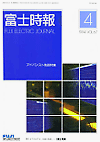FUJI ELECTRIC JOURNAL Vol.67-No.4 (Apr/1994)
 |
Advanced Control Technology |
Trends of Advanced Control Technology and Fuji Electric's Research and Development
Akira Asami, Ken'ichi Kurotani, Shigeo Kuroiwa
Advanced control has been coming into wide use in actual equipment and industrial plants. The control theory is still in progress and practicable methods such as robust control, adaptive control, model predictive control, digital control, and nonlinear control are attracting. attertion Fuji Electric positively tackled application of advanced control and supplied many systems and equipment making use of these methods. Software package for control system design was developed and expanded from early as well. It is essential to analyze problems in controlled systems fully and to apply the most suitable method for them.
Software Package"SAPL" for Control System Design and Analysis
Tomoji Kanno, Kazuteru Shinkai, Masamitsu Ito
Engineering with computer-aided analysis and simulation is indispensable to build advanced control systems. Fuji Electric developed software packages "SAPL"for control system design and analysis, which have been used in the company and also put on the market. This paper describes an outline and features of the SAPL series and introduces newly added functions and examples of application.
Tension Control of Steel Processing Lines by H∞ Control
Kouichi Takahashi, Yoshiaki Ogusu, Shigeto Ouchi
Surface processing lines in steel plants requires maintaining material tension constantly at a specified value. At present, tension is controlled by PI controllers. However, because the lines have multiple inputs and outputs and are subject to intense interference, a satisfactory control characteristic is very difficult to be obtained. Fuji Electric designed a control system using H∞ control with high robustness in multiple input/output systems and carried out a simulation.
Application of Model Predictive Control to a Chemical Batch Process
Toshifumi Yamachi, Masamoto Takano
Chemical plants promoted application of a distributed control system (DCS) and achieved rather high automation. However, some of the plants are difficult to be fully controlled only by a DCS and have to depend on operator's adjustment. Aiming at sophisticated plant control, Fuji Electric developed an advanced control system using model predictive control technology and put it to practical use, which has improved productivity, stabilized quality, and reduced operator's adjustments to the control operations.
Advanced Control of a Coagulation Process for Water Purification Plants
Masakazu Kubota, Tokio Ohto, Kiyoshi Kazama
A coagulation process for water purification plants mainly uses feedforward control based on raw water quality and requires operator's help. Fuji Electric developed a floc sensor for measuring floc size, with which mixing pond floc size was made controllable. A control system using model predictive control was developed. It was experimentally confirmed that treated water quality was kept good by controlling mixing pond floc size and automatic control with feedback from the coagulation process was practicable. This control system is scheduled to be verified in an actual plant in future.
Application of Adaptive Control to Motor Drive Systems
Hidetoshi Umida, Takashi Aihara
Variable-speed motor drive systems are widely used in various application fields, where auto-tuning functions increasingly become important. Fuji Electric has developed these functions for mechanical systems and vector control systems based on adaptive control theories. As the use of variable-speed drives expands, a follow-up on parameter variation is demanded not only before but also during operation. We are developing tuning methods that enable on-line, optimal adjustment of controller constants. This paper introduces some developments for adaptive control application to motor drive speed regulators.
Learning Control of Elastic Joint Robots
Masayoshi Wada
Requirements for the high speed motion of robots have continued to increase. In the high speed motion, robots often oscilate because of insufficient rigidity of the arm. Conventional controls for elastic joint robots are difficult to apply in practice because of its complicatedness and necessity for making a model. Fuji Electric has proposed learning control for elastic joint robots. The effectiveness of the proposed control scheme is verified by experimental results with testing equipment and with actual industrial robot.
Stress Analysis of Epoxy Resin Moldings
Tatsuo Nishizawa, Takao Maeda, Hiroshi Moriya
Because of its superior insulation characteristic and mechanical property, epoxy resin is widely used in electronic components up to structural material for high voltage power equipment. Many moldings have built-in parts of parts of different material such as electrodes, and an external load or a change in temperature causes stress between the parts and resin. As devices got smaller and more complicated, the importance of three-dimensional stress analysis in their structural design has increased. Citing a pressure test and a heat cycle test used for property inspection, this paper shows the reliability of the analysis by comparing it with the measured result.
Three-Dimensional Magnetic Field Analysis
Michiru Fujita, Yu Ashida, Tatsuo Take
Among Fuji Electric's original three-dimensional magnetic field analyses, this paper presents an outline and application examples of the integral equation method. The method was applied to static magnetic field problems taking the magnetic moment vector of magnetic material as a variable, to eddy current problems taking current vector potential on the conductor as a variable, and to scattering problems taking currents on the antenna as a variable. We contrived to reduce the CPU time, improve calculation accuracy, and make the method suit various problems.
IIIuminance Distribution Simulation for Power Supply Apparatus
Yu Ashida, Shin'ichi Kai, Michiru Fujita
Studies are being made on fault prevention by detecting discharge phenomena with optical sensors in switchgear, etc. This paper introduces an outline and calculation example of a program to determine the suitable location of optical sensors. We regard discharge light as a collection of particles and pursue particle loci with random numbers; thus light distribution simulation on the inside surface of the equipment wall is obtained. The paper shows pertinence by comparing measurement and calculation with a mimic discharge light in a cylindrical model tank, and then calculation for the bus bar connector of gas-insulated switchgear.

